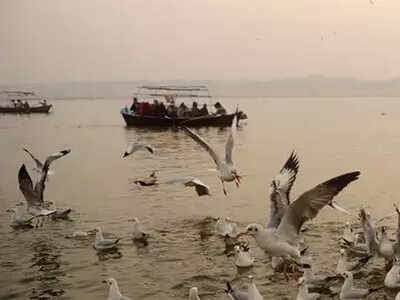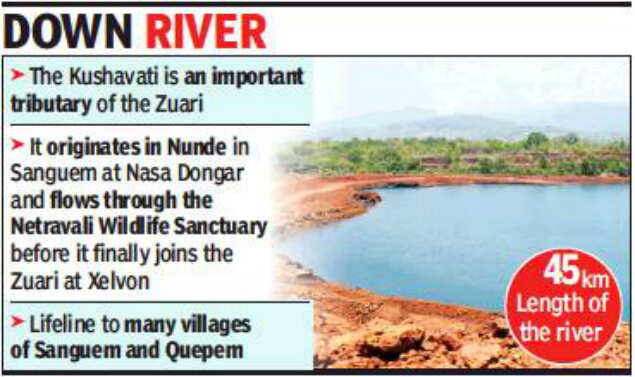
KERI: The ghost of mining past has come to haunt residents and farmers of Quepem and Sanguem talukas who are reeling under acute water shortage with the Kushavati witnessing a drastic drop in water level, the first time in decades. Locals and environmentalists are blaming mining and other anthropogenic activities, which have not only resulted in the base flow or subsurface flow of the river being diverted, but also in reduction of the river depth.

“For the first time in 20 years we have seen the Kushavati water level dip,” horticulturist Vitthal Khandeparkar of Usgalimol in Pirla-Quepem said.
Environmentalists laid the major portion of the blame on haphazard mining activities in the river’s catchment area without adequate environmental safeguards. While open-pit mining operations has diverted the baseflow of the river, siltation by mining sediment has reduced its depth, they said.
“There are huge mining pits on either banks of the river. The level of these pits is far below the riverbed level, which cuts off the subsurface flow into the river. Nearby surface water bodies have also been affected,” Khandeparkar said.
As per WRD information, there are almost 70 mining leases within 1km of the Kushavati. Of these, more than a dozen were operational. Today, though mining has stopped, laterite quarrying continues, which is affecting the Kushavati and its feeders.
Social activist John Fernandes from Quepem told TOI, “Mining and quarrying has badly affected the flood plains of the river. The natural flow has been affected by mining silt run-off during the monsoon. The course of the Kushavati and it’s flow has been degraded.”
The farmers and horticulturists from Sulcorna, Cavrem, Maina, Pirla and Rivona are now paying the price for all these haphazard, unplanned and anthropogenic activities. With paucity of irrigation water due to decrease in Kushavati’s flow, horticultural crops have been affected.
Khandeparkar said another problem was irresponsible behaviour by picnickers in the area. “A large number of picnickers come here for a swim. It is found that they remove the plates of the vasant bandharas,” he said, adding that garbage dumping is also degrading the river.
Chief engineer water resources department (WRD) Shrikant Patil told TOI, “There is need of vigilant local population like villagers of Sal in Bicholim. Our officials cannot solely monitor the vasant bandharas. Locals have to come forward in discouraging picnickers.”
Medical practitioner and horticulturist from Kitamorod-Colomb in Sanguem, Avadhut Prabhudesai said, “We have protected our 50 acre horticulture farm by not allowing deforestation. Everyone has to contribute in protecting the catchment area and flood plain of the river. Only then will we be able to protect the natural flow of the river.”

“For the first time in 20 years we have seen the Kushavati water level dip,” horticulturist Vitthal Khandeparkar of Usgalimol in Pirla-Quepem said.
Environmentalists laid the major portion of the blame on haphazard mining activities in the river’s catchment area without adequate environmental safeguards. While open-pit mining operations has diverted the baseflow of the river, siltation by mining sediment has reduced its depth, they said.
“There are huge mining pits on either banks of the river. The level of these pits is far below the riverbed level, which cuts off the subsurface flow into the river. Nearby surface water bodies have also been affected,” Khandeparkar said.
As per WRD information, there are almost 70 mining leases within 1km of the Kushavati. Of these, more than a dozen were operational. Today, though mining has stopped, laterite quarrying continues, which is affecting the Kushavati and its feeders.
Social activist John Fernandes from Quepem told TOI, “Mining and quarrying has badly affected the flood plains of the river. The natural flow has been affected by mining silt run-off during the monsoon. The course of the Kushavati and it’s flow has been degraded.”
The farmers and horticulturists from Sulcorna, Cavrem, Maina, Pirla and Rivona are now paying the price for all these haphazard, unplanned and anthropogenic activities. With paucity of irrigation water due to decrease in Kushavati’s flow, horticultural crops have been affected.
Khandeparkar said another problem was irresponsible behaviour by picnickers in the area. “A large number of picnickers come here for a swim. It is found that they remove the plates of the vasant bandharas,” he said, adding that garbage dumping is also degrading the river.
Chief engineer water resources department (WRD) Shrikant Patil told TOI, “There is need of vigilant local population like villagers of Sal in Bicholim. Our officials cannot solely monitor the vasant bandharas. Locals have to come forward in discouraging picnickers.”
Medical practitioner and horticulturist from Kitamorod-Colomb in Sanguem, Avadhut Prabhudesai said, “We have protected our 50 acre horticulture farm by not allowing deforestation. Everyone has to contribute in protecting the catchment area and flood plain of the river. Only then will we be able to protect the natural flow of the river.”
Make sense of the 2019 Lok Sabha elections and results on May 23 with TOI. Follow us to track latest news, live updates, news analysis and cutting-edge data analytics. Track live election results, the big trends and fastest updates on counting day with India's largest news network.
#ElectionsWithTimes
Quick Links
Lok Sabha Election Schedule 2019Lok Sabha Election NewsDelhi Capitals teamMI team 2019Rajasthan Royals 2019RCB team 2019Maharashtra Lok Sabha ConstituenciesBJP Candidate ListBJP List 2019 TamilnaduShiv Sena List 2019AP BJP List 2019Mamata BanerjeeBJP List 2019 MaharashtraPriyanka GandhiBJP List 2019 KarnatakaAMMK Candidate List 2019BJP List 2019 WBLok Sabha Elections in Tamil NaduBSP List 2019 UPNews in TamilLok Sabha Poll 2019Satta Matka 2018PM ModiMahagathbandhanNagpur BJP Candidate ListChandrababu NaiduTamil Nadu ElectionsUrmila MatondkarNews in TeluguMadras High CourtTejashwi YadavArvind KejriwalTejasvi SuryaPawan KalyanArvind KejriwalYogi AdityanathJaya PradaSatta King 2019Srinagar encounter
Get the app









